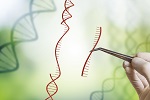
The DNA in the nucleus of our cells is inherited from our parents, so if we compared the structure of our DNA with our parents, they'd be the same, right? Well, they're not.
One reason is our jumping genes which are also called transposons. They're pieces of genetic information that randomly move about the genome. It's not a problem unless one inserts itself into an important gene and causes cancer.
One jumping gene is called LINE-one, or Long Interspersed Nuclear Element One and represents nearly a fifth of the DNA in every cell. Up until recently they were considered 'junk DNA'.
Given that so many copies of LINE-one have been retained in the human genome throughout evolution, it does not make sense that it is merely junk DNA. A post-doctoral fellow decided to study how LINE-one affects embryonic development which scientists had already known causes Line-One to be highly active.
The researcher devised a way to turn off LINE-one in mouse embryos. This caused the embryo to stop at the two-cell stage which is immediately after a fertilized egg splits the first time. However, when LINE-one was turned back on but not allowed to jump, there was no effect on embryo development.
This means, LINE-one plays an important role in the developing embryo but its ability to move about the genome has nothing to do with that role. Perhaps it serves as 'molecular glue' to bring together molecules that turn off portions of the genome at the two-cell stage to allow other genes to further embryo development.
We don't know yet if LINE-one has the same functions in humans. What is clear is that it's not junk DNA.
More Information
A LINE1-Nucleolin Partnership Regulates Early Development and ESC Identity
Transposable elements represent nearly half of mammalian genomes and are generally described as parasites, or 'junk DNA.' The LINE1 retrotransposon is the most abundant class and is thought to be deleterious for cells, yet it is paradoxically highly expressed during early development. Here, we report that LINE1 plays essential roles in mouse embryonic stem cells (ESCs) and pre-implantation embryos...
A lncRNA-like Role for LINE1s in Development
Transposable elements (TEs) have profoundly affected the evolution of transcriptional and chromatin profiles in mammalian genomes. In a recent paper, Percharde et al. (2018) identify a lncRNA-like function for LINE1 transposable elements in regulating gene expression to facilitate embryonic stem cell self-renewal and preimplantation development...